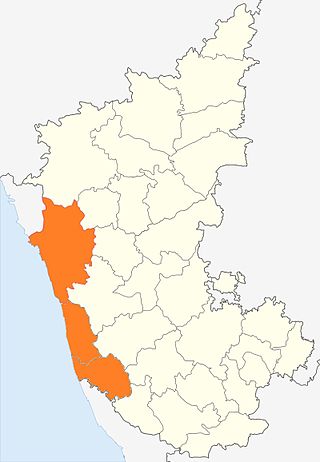
Kanara or Canara, also known as Karavali is the historically significant stretch of land situated by the southwestern coast of India, alongside the Arabian Sea in the present-day Indian state of Karnataka. The subregion comprises three civil districts, namely: Uttara Kannada, Udupi, and Dakshina Kannada. Kassergode was included prior to the States Reorganisation Act.
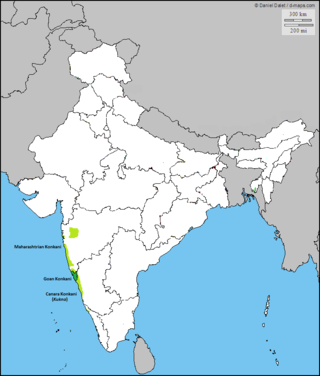
Konkani is an Indo-Aryan language spoken by the Konkani people, primarily in the Konkan region, along the western coast of India. It is one of the 22 scheduled languages mentioned in the Indian Constitution, and the official language of the Indian state of Goa. It is also spoken in Karnataka, Maharashtra, Kerala, Gujarat as well as Damaon, Diu & Silvassa.

Salcete is a subdivision of the district of South Goa, in the state of Goa, situated by the west coast of India. The Sal River and its backwaters dominate the landscape of Salcete. Historically, the sixty-six settlements south of the Zuari River formed the original Salcette territory. Salcete forms a part of the bigger Konkan region that stretches along the western shoreline of peninsular India.
Saraswat Brahmins are Hindu Brahmins, who are spread over widely separated regions spanning from Kashmir and Punjab in North India to Konkan in West India to Kanara and Kerala in South India. The word Saraswat is derived from the Rigvedic Sarasvati River.
Kamat or Kamath is a surname from Goa, Maharashtra and coastal Karnataka in India. It is found among Hindus of the Goud Saraswat Brahmin, Saraswat and Rajapur Saraswat Brahmin communities following Madhva Sampradaya of either Gokarna Matha or Kashi Matha.
The Konkani people are an Indo-Aryan ethnolinguistic group native to the Konkan region of the Indian subcontinent who speak various dialects of the Konkani language. Konkani is the state language of Goa and also spoken by populations in Karnataka, Maharashtra, Damaon and Kerala. Other Konkani speakers are found in Gujarat state. A large percentage of Konkani people are bilingual.
Gaud Saraswat Brahmins (GSB), also known as Shenvis are a Hindu community of contested caste status and identity. They primarily speak Konkani and its various dialects as their mother tongue, and claim to be Saraswat Brahmins who initially migrated to Konkan from Gaud, per Puranic accounts. Upon moving out of Goa, their claims of Brahminhood were rejected both to the north, by the Deshastha, Chitpavan and Karhade Brahmins of Maharashtra, and to the south, by the Nambudiri Brahmins of Kerala, and were not recognized in British colonial records.
Mangalorean Catholics are an ethno-religious community of Latin Christians from the Diocese of Mangalore and the erstwhile South Canara area, by the southwestern coast of present-day Karnataka, India.
Shenoy is a surname from coastal Karnataka and Goa in India. It is found among Hindus of the Goud Saraswat Brahmin community following Smartha Sampradaya of Kavale Matha or Madhva Sampradaya of either Gokarna Matha or Kashi Matha.
Goans is the demonym used to describe the people native to Goa, India, who form an ethno-linguistic group resulting from the assimilation of Indo-Aryan, Dravidian, Indo-Portuguese, Austro-Asiatic ethnic and/or linguistic ancestries. They speak different dialects of the Konkani language, collectively known as Goan Konkani. "Goanese", although sometimes used, is an incorrect term for Goans.
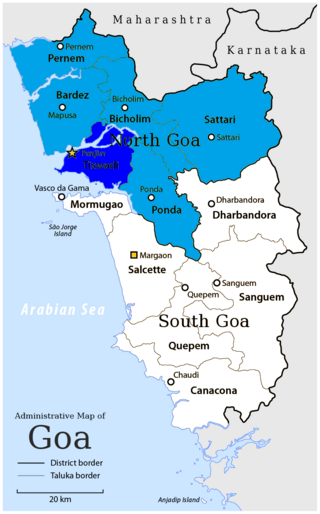
Tiswadi, formerly known as Ilhas, is a taluka in the district of North Goa, situated in the Indian coastal state of Goa. It is an estuarine island situated on the confluence of the Mandovi and Zuari rivers. It was one of the first territories to be annexed by the Portugese in the 16th century. Both the state capital Panaji, and the erstwhile capital Old Goa lie within the sub-district. It is the biggest and the most populated of the six major islands between the Mandovi and Zuari rivers.
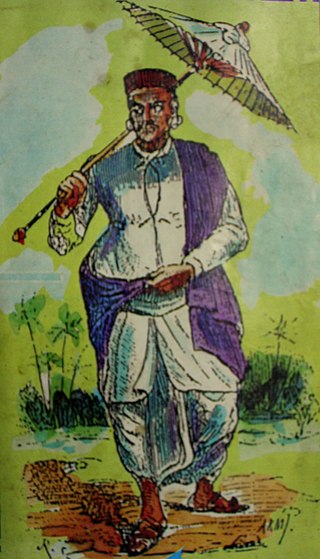
The Daivadnya,, is a Konkani community, who claim to have descended from Vishwakarma, Hindu architect god and part of larger Vishwakarma community. They are native to the Konkan and are mainly found in the states of Goa and Damaon, Canara, coastal Maharashtra, and Kerala.
Konkani may refer to:
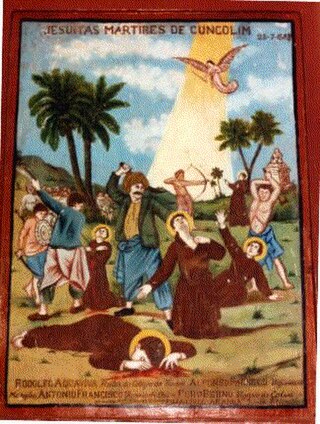
Roman Catholic Kshatriyas are a modern Christianised caste among Goan, Bombay East Indian, Mangalorean, Kudali & Karwari Catholics. They are the patrilineal descendants of Kshatriya and Vaishya Vani converts to the Latin Church, in parts of the Konkan region that were under Portuguese Goan rule. They are known as Chardo in Goan Konkani, Charodi in Canarese Konkani & as Sandori or Vadval in Damanese and Mahraashtrian Konkani, while others also identify as Khatri in the Bombay East Indian dialect. The well known households and well to do individuals among them, have mostly been endogamous.
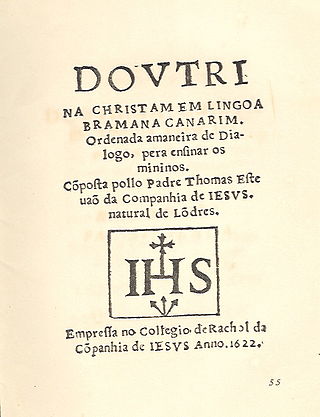
Konkani in the Roman script, commonly known as Roman Konkani or Romi Konknni refers to the writing of the Konkani language in the Roman script. While Konkani is written in five different scripts altogether, Roman Konkani is widely used. Roman Konkani is known to be the oldest preserved and protected literary tradition beginning from the 16th century AD.
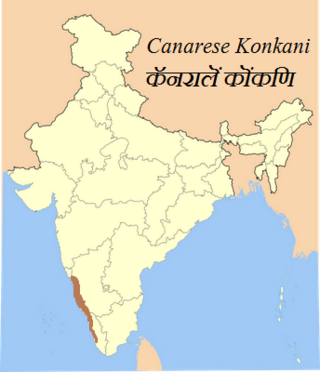
Canarese Konkani are a set of dialects spoken by minority Konkani people of the Canara sub-region of Karnataka, and also in Kassergode of Kerala that was part of South Canara.
The Konkani language agitations were a series of protests and demonstrations in India, concerning the uncertain future and the official status of the Konkani language. They were held by Goans in the then union territory of Goa, Daman and Diu under the Maharashtrawadi Gomantak Party. The protests involved citizen journalism, student activism and political demonstrations.

The Goan Muslims are a minority community who follow Islam in the Indian coastal state of Goa, some are also present in the union territory of Damaon, Diu & Silvassa. They are native to Goa, unlike recent Muslim migrants from mainland India and are commonly referred to as Moir by Goans in Goan Konkani. Moir is derived from the Portuguese word Mouro. The Portuguese called them Mouros because they were in contact with the Moors, people of predominantly Muslim Maghreb country, who had conquered and colonised the Iberian peninsula for centuries.

Goa is a state on the southwestern coast of India within the Konkan region, geographically separated from the Deccan highlands by the Western Ghats. It is bound by the Indian states of Maharashtra to the north, and Karnataka to the east and south, with the Arabian Sea in the west. It is India's smallest state by area and fourth-smallest by population. Goa has the highest GDP per capita among all Indian states, two and a half times as high as the GDP per capita of the country as a whole. The Eleventh Finance Commission of India named Goa the best-placed state because of its infrastructure, and India's National Commission on Population rated it as having the best quality of life in India. It is the second-highest ranking among Indian states in the human development index.
The East Indian language or East Indian dialect, also known as Mobai Mahratti and East Indian Marathi, is the form of Marathi-Konkani languages spoken in Bombay (Mumbai). It has a significant amount of Indo-Portuguese loanwords. It does not have a unique script of its own: Devanagari and the Roman script are used by most of its speakers, who are the native Christians of the Seven Islands of Bombay in the northern Konkan division. Though the dialect is losing popular usage due to immigration, depopulation & Anglo-Americanisation among most of the younger generation. It is still used by some for songs and dramas, as well as in Christian worship since the Novus Ordo was approved in the 1960s.